2012 VOLKSWAGEN GOLF MK6 transmission
[x] Cancel search: transmissionPage 282 of 516

transmission into 1st gear (on
and the out.
keys with you when
Before stopping the en gine, turn the steer ing so th at, if the starts to into the curb :
turn the fro nt
Facing
The
on page 179.
New
brake pads do not provide to km)
and must first be To some extent,
you can make up for th e somewhat reduced
formance by more pressu re to t h e brake But, during the break-in period, the
be the brakes are ken in. Avoid hard braking a nd situatio ns that might
requ ire hard brakin g (such as
on operati ng
condit ions and the way the
you
serv ice
damage your bumper and related parts if the front of your vehicle hits a barrier or curb that is too high you are
getting into or out of a parking spot. To
to the ground may be damaged (such as bumper covers, spoilers, and parts of the en-
gine , suspension, and exhaust systems).
icy. Wet or icy brakes must be dried as soon as by high speed.
Make sur e nobody is behind you and that you do
not enda nge r
or othe rs
t her e is on th e roads and you are not braking brake move any
Brake disc corrosion (rust) and dirt to occur if the is not driven much or is driven fo r short
distances with the brakes have not
been used and th ere is some rust on the discs, the brake discs and pads once in a by
shifting, parking
Page 283 of 516
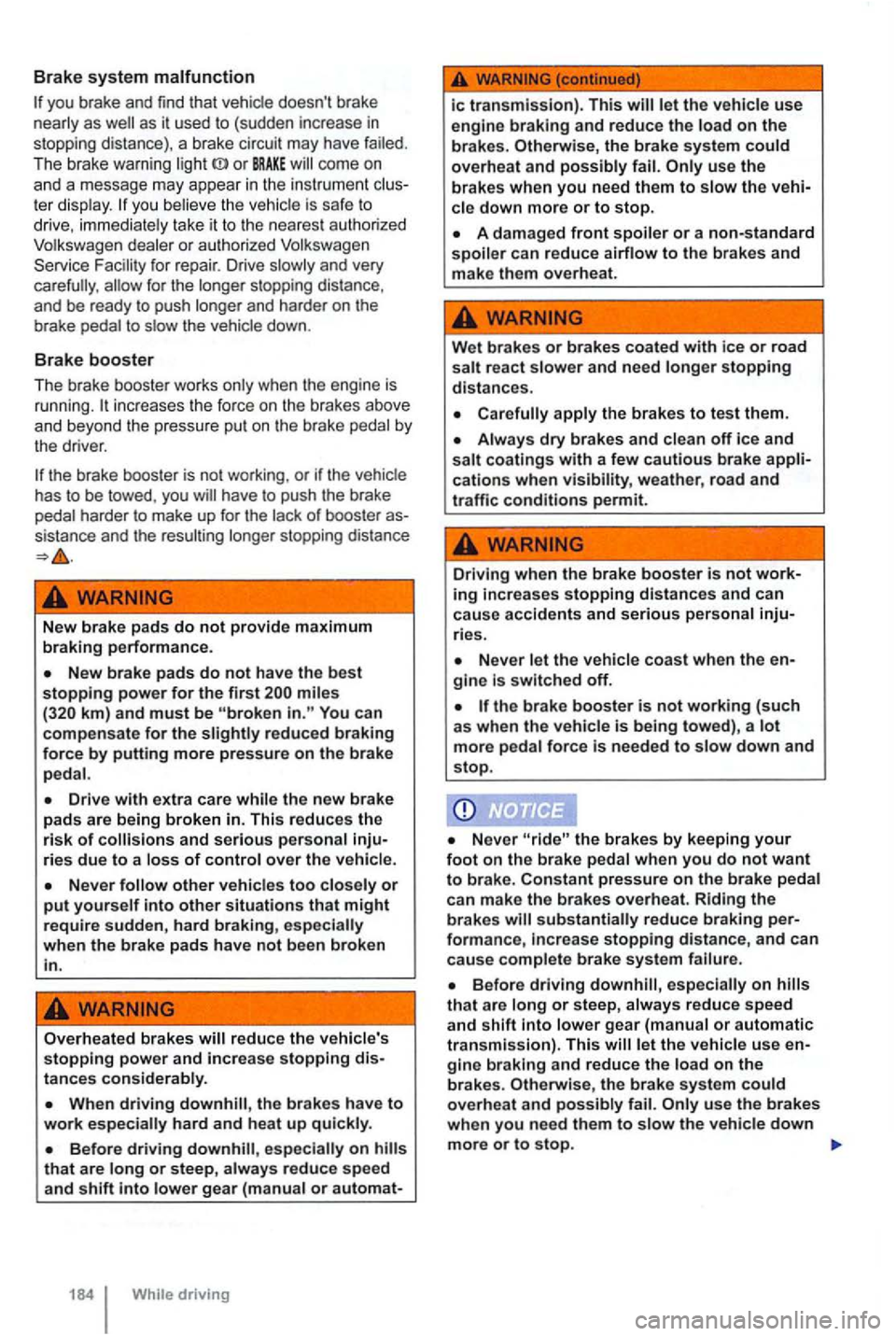
Brake system malfunction
you brake and find that vehicle doesn't brake
nearly as
come on
and a m essage may appear in the instrument ter display. you believe the vehic le is safe to
d rive, immediately take it to the nearest authorized
Volkswagen dealer or authorized Volkswagen
Service
f or repair. Drive slowly and very
carefully , for the longer stopping distance ,
and be ready to push longer and harder on the
brake pedal to slow the vehicle down.
Brake booster
The brake booster works only when the engine is
running . in creases the force on the brakes above
and beyond the pressure put on the brake pedal by
the driver .
New brake pad s do not provide maximum braking performance.
miles You can
compensate for the reduc ed braking force by putting more pressure on the brake
pedal.
other vehicles too closel y or put yourself into other situations that might require sudden, hard braking , especially
when the brake pads have not b ee n broken
in.
Overh eated brakes reduce the vehicle's stopping power and increa se stopping distances considerably.
that are long or s teep, always reduce speed
and shift into lower gear (manual or automat-
184 While driving
ic transmission). This let the vehicle use
engine braking and reduce the load on the brakes. Otherwise, the brake system could overheat and possibly fail.
A damaged front spoiler or a non-standard spoiler can redu ce airflow to th e brakes and make them overheat.
Wet brakes or brakes coated with ice or road
salt react slower and need longer stopping distances.
apply the brakes to tes t them .
Driving when the brake booster is not working increases stopping distances and can
cause accidents and serious per sonal inju
rie s.
Nev er let the vehicle coas t when the
the bra ke booster is not working (suc h
a s wh en th e vehic le is being towed) , a lot more pedal force is needed to slow down and stop.
Neve r the brake s by keeping your foot on the brak e pedal when you do not want to brak e. Constant pres sure on the brake ped al
ca n make the brak es overheat. Riding the bra kes substantially r educe brakin g performance, increase stopping distance, and can
cause complete brake system failure .
that are long or s teep, always reduce speed and shift into lower gear (manua l or automatic tran smission). This gine brakin g and reduce the load on t he brakes. Otherwise, the brake system cou ld
o ve rheat and possibly fail. use the brakes when you n eed them to slow the vehicle down more or to stop.
Page 295 of 516

conditions are
3. A manual transm iss ion vehic le must be in 1st
gear (1 ) i f headed up a or in Reverse (R ) if backing up a you must hold the clut ch down
and the foot brake must be depressed to keep
the vehic
le from moving.
' Rel
ease
the brake as you let the clutch out and gently depress the accelerator.
any requi rement lis ted in the tab le above is
no longer met (see 196 , ed automatically when the following conditions are all met at the same time.).
gine malfunctions .
Automatic transmission vehicles: the mission i s in Neutral (N).
Automatic transmission vehicles:
and
the foot brake must be depressed to keep the
vehic le from moving .
Relea
se the brake as you gently depress the accelerator.
cle in start situations (for example, if the surface icy or slippery).
down the
Page 322 of 516
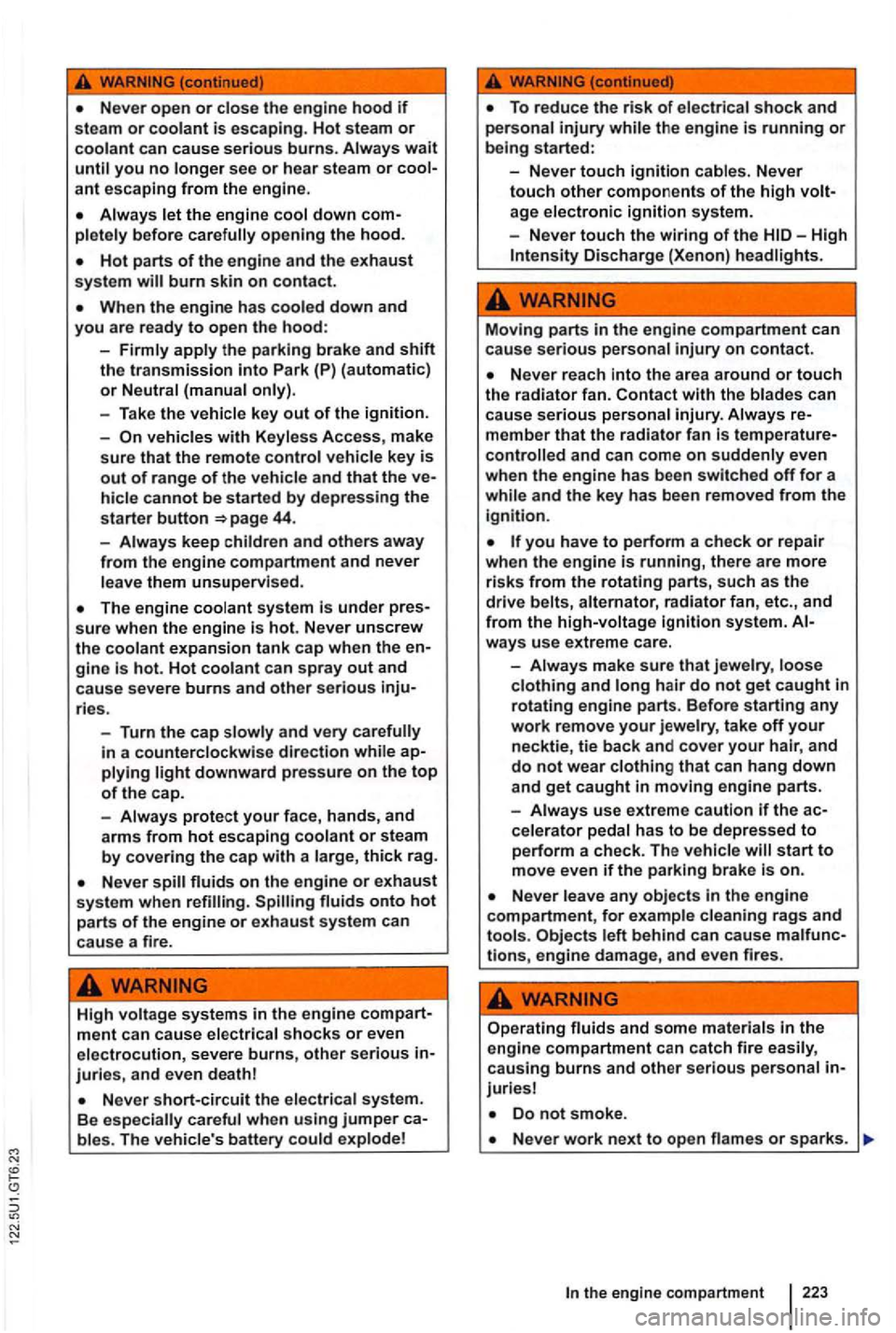
Never open or close the engine hood if To reduce th e risk of electrica l shock and steam or coolant is escaping. Hot steam or personal injury
-Never touch ignition cables. Never ant escaping from the engine. touch other components of the high
Always the eng ine down com-age electronic ignition syste m .
opening the hood.
-Never touch the wiring of the Discharge (Xenon) headlights.
system burn skin on contact.
you are read y to open the hood: Moving parts in th e engine compartment can
- Firm ly apply the parking brake a nd shift cause serious personal injury on contact. the transmission into Park (P) (automatic)
vehicles with Keyless Access, make member that the radiator fan is temperature-
s
ure that the remote contro l vehicle key is controlled and can come on sudden ly even
out of range of th e vehicle and that the ve- when the engine
has been switched off for a
hicl e cannot be started by depres sing the 44. ignition.
-
Always keep children and others away you have to perform a check or repair from the engine compartment and never when the engine is runn ing, there are more leave them unsupervised. risks from the rotating parts, such as the
hair do not get caught in
ries. rotating engine
parts. B efore starting an y
- Turn
the cap
fluids onto hot parts of the engine o r exhaust system can
cause a fire. -
Always use
extreme caution if the ac-
ce lerato r pedal has to be depressed to perform a check. The vehicle will start to move even if the parking brake i s on.
Never leave any objects in the engine compartment, for examp le cleaning rags and tools. Objects left b ehind can cause malfunc-lions, engine damage, and even fires.
High voltage sy stems in the engine com part-ment can ca use electrica l shocks or even
electrocution, severe burns, other serious in-juries, and eve n deathl
Neve r short-circuit the electrica l syste m .
B e especially ca reful when using jumper ca-
Operating fluids and some materials in the engi ne compartment can catch fire easily, causing burns an d other serious personal in-juries
Do not smoke .
b les. The
vehicle 's battery could exp lode! Never work next to open flames or sparks .
223
Page 386 of 516

it must be re placed.
proved by Volk swag en. H av e them
ry tools and diagn os tic equipment to properly re place any airbag in your vehicle and assure
s y s te m effective ness in a cras h.
in yo ur ve hicle.
on p ag e 28 3.
An outside antenna is required for the ope ration of radio equipment in the vehicle.
Volkswagen approves th e opera tion
of radio cond it ions:
Professionally
Maximum transmission power 1
ers an d authorized Volkswagen Facilities
are familiar with tech nical poss ibilities for the
Undeployed airbag modules and safety belt pretensioners are classified as Perchlorate
Material . handling may apply-see http:/1 www.dtsc.ca.gov/hazardouswaste/pe rchlorate . applicable legal requ irements regardi ng
handling and disposal of the vehicle or parts of its
r es train t system , in cluding airbag modules and
safe ty belts with pretensioners . Authorized
Faci lities are fami liar with the requirements, and
we recommend that you have them perform this
service for you.
Loose or imprope rly m ent ca n b e thrown around the passe nge r compartment during sudden driving or
le d p roperly.
Notice about data recorded by vehicle control modules
on pag e 28 3.
Your vehicle is not equipped with an Event Data
Re corder (EDR) . EDRs,
sometimes called "crash recorders
," are
pose of capturing data for retri eval after an dent or crash event.
state laws restrict the retrieval or ing of data stored by EDRs installed in a vehicle for
the express purpose of retrieving data after an cide nt or crash event without th e owner's consent.
Veh ic le care and maintenan ce
Page 403 of 516
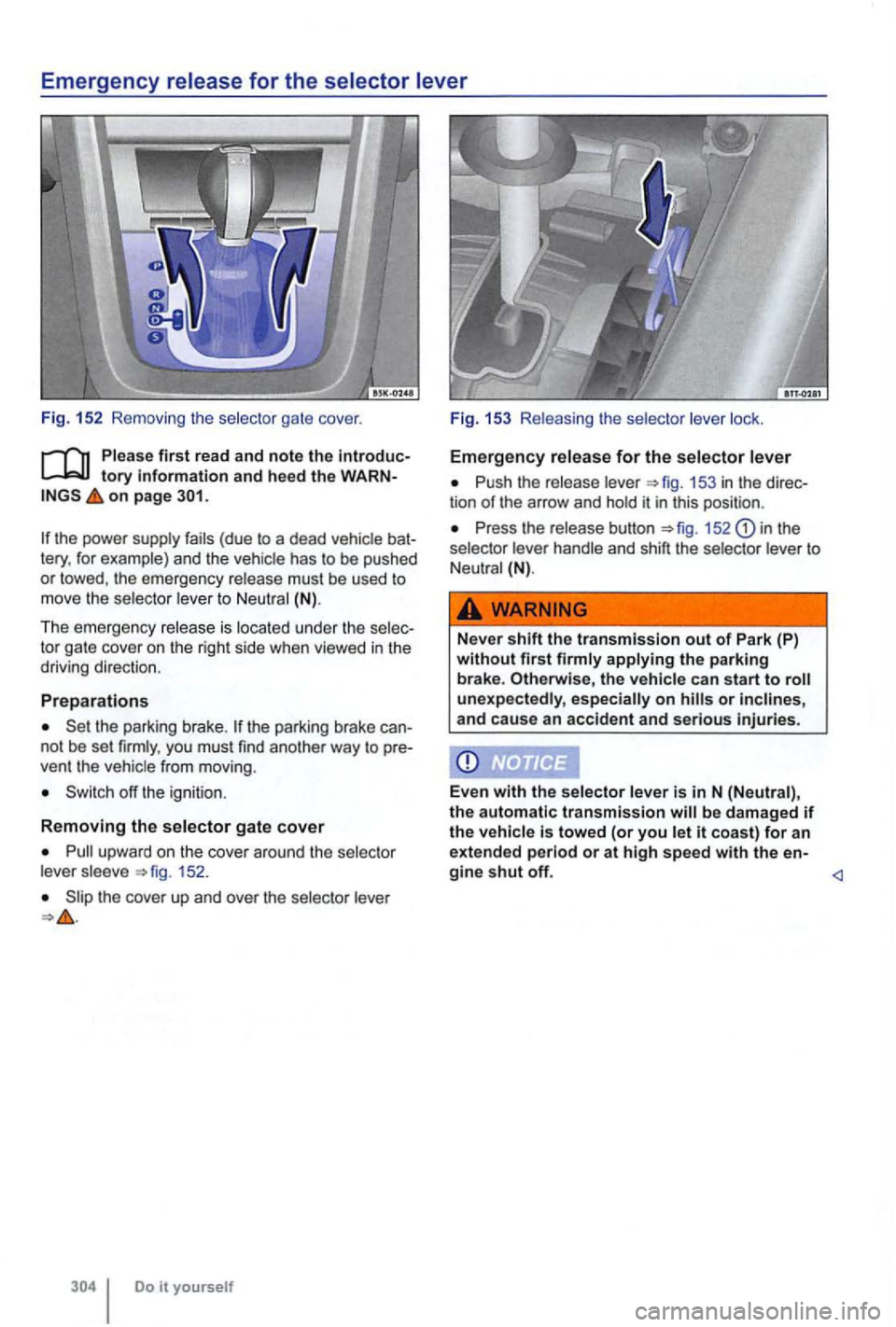
Emergency
on page
the power supply fails (due to a dead vehicle bat
tery , for example) and the vehicle has to be pushed or towed , the emergency release must be used to move the selecto r lever to N eutral (N).
Th e emerge n
cy release is located under the selec
tor gate cover on the right side when viewed in the
driving direction .
Preparations
Set the parking brake. the parking brake can
no t be set firmly , you must find another way to pre
vent the vehic le from moving .
Switch off the ignit ion.
Removing the selector gate cover
Pull upward on the cover aroun d the selec tor
lever sleeve fig. 152 .
Slip the cover up and over the selector lever
Push the release lever 153 in the direc
t ion of the arrow and hold it in this position .
Press the release button fig. 152 the
selector lever handle and shift the selector lever to Neu tral (N) .
WARNING
Never shift the tran smi ssion out of Park (P) without first firmly applying the parking
brake . the vehicle can start to roll unexp ectedly, especially on hills or inclines,
a nd cause an accident and serious injuries.
Ev en
with the selector lever is in N (Neutra l), the automatic transmission will b e damaged if the vehicle is towed (or you let it coast) for an extended period or at high speed with the en-
gine shut off.
Page 409 of 516
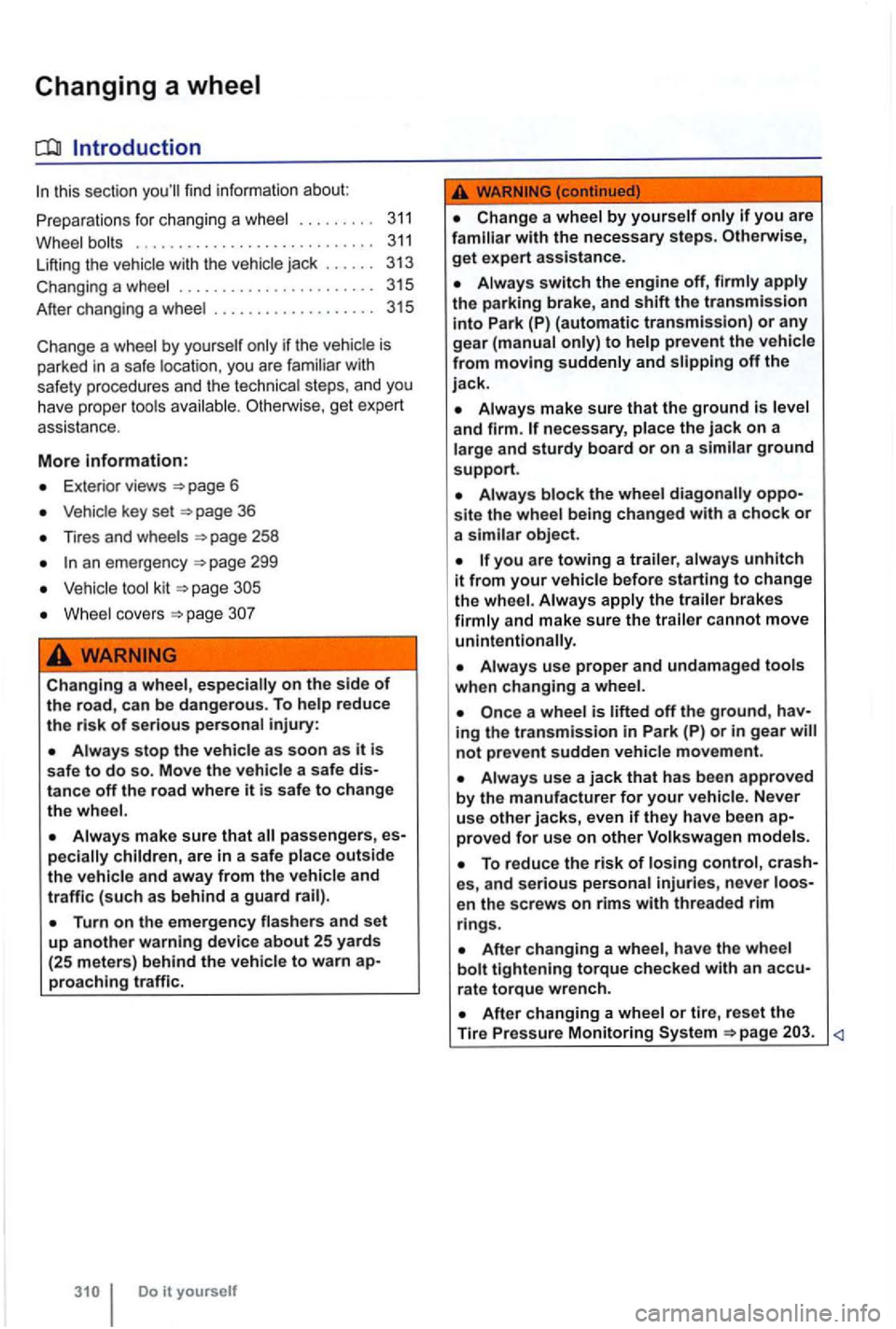
Changing a wheel
Introduction
this sect ion you 'll find informati on about:
for changi ng a wheel . . . . . . . . . 311
Wheel bolts . . . . . . . . . . . . . . . . . . . . . . . . . . . . 311
Lifting the vehi cle with the vehicle jack . . . . . . 313
Changing a whee l ....................... 315
After ch anging a wheel
................... 315
Change a wheel by yourse lf only if the vehicle is
park ed in a safe loca tion , you are fam
ilia r with
safe ty procedures and the technical steps, and you
ha ve proper too ls ava ilable . Otherwise , get expert
ass istan
ce.
More information:
Exterior views 6
Vehicle key set
Tires and whee ls 258
an em ergency
Vehicle tool kit
W heel covers
Changing a wheel ,
proaching traffic.
you are towing a trailer, always unhitch it from your vehicle before starting to change the wheel. Always apply the trailer brakes firmly and make sure the trailer cannot move unintentionally.
ing the transmission in Par k (P) or in gear
proved for use on other Volkswagen models.
es , and serious personal injuries, never en the screws on rims with threaded rim rings.
rate torque wrench.
Page 420 of 516
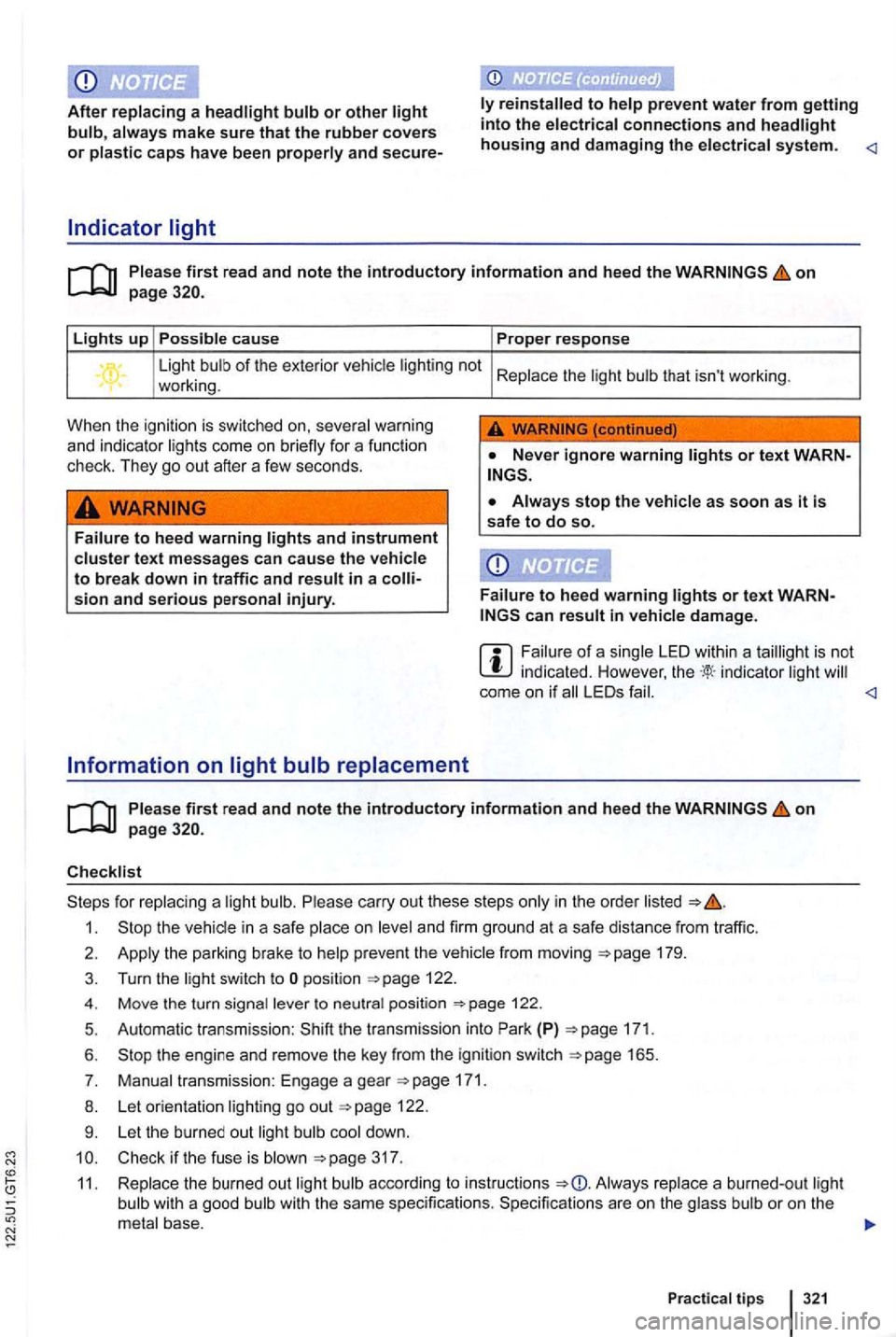
N
After replacing a headlight bulb or other light bulb, always make sure that the rubber covers or plastic caps have been properly and secure-
Indicator light
to help prevent water from getting into the electrical connections and headlight housing and damaging the electrical system.
on
Lights up Possible cause Proper response
Light bulb of the exterior vehicle lighting not Replace the light bulb that isn't working .
working .
When the ignition is switched on, several warning
and indicator lights come on briefly for a function
check . They go
out after a few seconds.
WARNING
Failure to heed warning lights and instrument cluster text messages can cause the vehicle to break down in traffic and result in a
can result in vehicle damage.
indicated. However, indicator light come on if LEO s fail.
on
Checklist
for replacing a light bulb. Please carry out these steps only in the order listed
1.
179.
3.
4.
5.
6 .
7.
8.
9 .
position
122 .
Automatic transmission :
the transmission into Park (P) 171.
the engine and remove the key from the ignition switch 165.
Manual transmission: Engage a gear
122.
Let the burned
out light cool down.
Check
if the fuse is blown 317 .
Replace the burned
out light according to
Practical tips 321